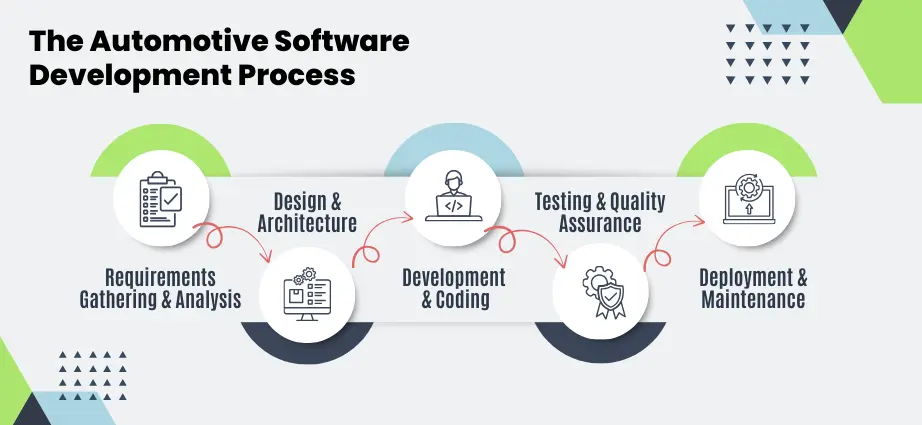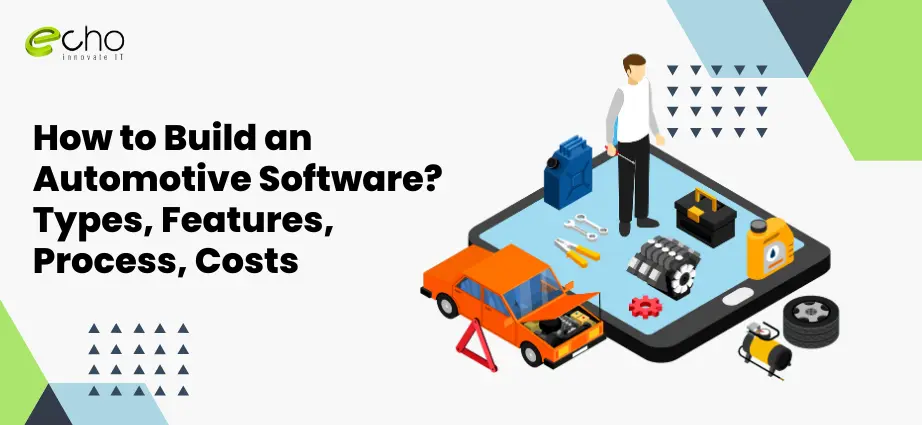The automobile software landscape has shifted dramatically in recent years owing to technological improvements and changing consumer expectations. From basic digital dashboards to complicated systems that enable self-driving, software has become an essential component of modern vehicles. Automotive software improves vehicle performance, safety, and user experience. Automotive software refers to computer applications created expressly for use in autos. These programs regulate a variety of car operations and features, including basic engine management and advanced driver assistance systems (ADAS).
These are specialized computer systems built into the vehicle’s hardware that govern operations such as engine management, transmission control, and safety systems. These provide amusement and information to drivers and passengers, including amenities such as navigation, music systems, and smartphone connectivity. These systems, which utilize sensors and software to aid drivers and increase safety, include adaptive cruise control, lane departure warning, and automatic emergency braking. These facilitate connection between the car and external systems, allowing for capabilities like remote diagnostics, vehicle tracking, and over-the-air upgrades.
In today’s blog, we are going to dive deeper into the world of automated software, its types, features, and costs, and learn how to build an automotive software. We will also explore IoT app development, which is crucial for integrating smart technologies into vehicles. Understanding these factors allows one to get useful insights into the world of automotive software and recognize its importance in the automobile industry.
Types of Automotive Software
1. Embedded Software
Modern automobiles rely on embedded software to operate. It is extensively embedded into the vehicle’s hardware, controlling a variety of important operations. This program functions in real-time, allowing for fast responses to changing conditions. For example, the engine control unit (ECU) controls engine performance, fuel efficiency, and emissions. It constantly analyzes numerous parameters such as engine speed, air-fuel ratio, and temperature to maximize engine performance.
Similarly, the transmission control unit (TCU) monitors the vehicle’s transmission to ensure smooth gear shifts and peak performance. In essence, embedded software is the unseen energy that propels modern cars. It is accountable for everything, from engine performance to safety features, ensuring a smooth and efficient driving experience.
2. Infotainment Software
Infotainment software is the digital heart of modern automobiles, designed to keep drivers and passengers entertained and informed while they travel. It includes a number of features that improve the driving experience and make long journeys more enjoyable. Multimedia is a major aspect of infotainment software. This consists of the ability to play audio, video, and other media files. Navigation systems are another crucial aspect.
These systems use GPS technology to display turn-by-turn directions, maps, and places of interest. Bluetooth connectivity connects your smartphone to the vehicle’s infotainment system. Smartphone integration improves connectedness even further. Finally, internet connectivity lets you connect to the internet while driving, providing capabilities like online navigation, streaming music and videos, and access to real-time traffic information.
3. Autonomous Driving Software
Autonomous driving software is the brains of self-driving vehicles. It is based on a complicated interaction between multiple sensors, cameras, and sophisticated algorithms. The ultimate goal is to attain Level 5 autonomy, which means a vehicle can run totally on its own without human intervention. However, the path to full liberty is fraught with problems.
Autonomous vehicles rely heavily on sensors such as cameras, LiDAR, and radar to detect their surroundings. These sensors must be accurate and reliable in all weather situations to ensure safe operation. Additional challenges include safety and legal frameworks.
4.Telematics Software
Telematics software connects automobiles and the digital world. Connecting vehicles to the Internet provides a variety of services that benefit both drivers and manufacturers. Remote diagnostics is a fundamental function of telematics software. This enables manufacturers to monitor the vehicle’s health and identify any problems before they arise. Another useful function is vehicle tracking. This allows owners to find their car in the event of theft or loss.
Over-the-air upgrades are another advantage of telematics software. In the event of an accident or emergency, telematics software can offer aid. Finally, connected services improve the driving experience by allowing access to a wide range of web functions. If you’re interested in learning how to develop a vehicle marketplace app, understanding these telematics features and their integration can be incredibly beneficial. Popular telematics services include SiriusXM and OnStar Connected Vehicle.
5. ADAS Software
Advanced Driver Assistance Systems (ADAS) have become standard features in modern vehicles, improving driver safety and convenience. These systems use sensors, cameras, and software to assist drivers with a variety of duties, lowering the chance of accidents and improving the overall driving experience. Adaptive cruise control is among the most frequent ADAS features. Lane departure warning uses cameras to track the vehicle’s position within its lane.
Blind spot monitoring employs sensors to detect vehicles in the driver’s blind spot. Automatic emergency braking can assist prevent or lessening collisions by automatically applying the brakes when the system detects an impending collision. Parking Assist employs sensors and cameras to aid drivers with parking their vehicles. Examples of advanced ADAS systems include Tesla Autopilot and BMW Driving Assistant Professional.
Are you looking for the best custom Software Development services in USA? Connect with us!
Essential Features of Automotive Software
User Interface
A well-designed user interface is straightforward, visually appealing, and simple to navigate. It should be in line with the overall vehicle design and branding. The program should be simple to learn and operate, especially for drivers who need to be more technically knowledgeable. Clear labeling, logical menus, and intuitive controls are required. Users should be able to customize their program experience by modifying settings, preferences, and themes.
Performance
To handle sophisticated activities such as real-time computations, sensor data processing, and multimedia playback, automotive software must have adequate processing power. The software should respond fast to user inputs and commands, resulting in a smooth and engaging experience. Automotive software must be extremely reliable, as errors can have catastrophic effects. Robust coding practices, thorough testing, and redundancy are required.
Security
Automotive software captures and saves sensitive data, such as vehicle information, driver preferences, and location information. To prevent unauthorized access to this data, strong security measures must be implemented. The program should be secure against cyberattacks such as hacking, malware, and data breaches. Regular upgrades, encryption, and firewalls are critical. Automotive software must adhere to applicable data privacy standards, such as GDPR and CCPA.
Scalability
Automotive software should be adaptable to future requirements and technology. This includes the capacity to interface with new hardware, support emerging features, and adapt to changes in legislation. Scalability should be considered when designing the software, allowing for simple updates and upgrades without requiring substantial rewrites.
Integration
Automotive software must work with a variety of hardware components, including sensors, controllers, and communications systems. The software should be able to work seamlessly with other software systems in the car, such as navigation, telematics, and autonomous driving systems. The software should handle standard communication protocols like CAN, LIN, and Ethernet to ensure interoperability with various vehicle architectures.
Step-by-Step Guide To Automotive Software Development Process

Requirements Gathering And Analysis
Determine the precise requirements and expectations of drivers, passengers, and car makers. This includes determining the intended features, functionality, and user experience. Determine the accurate capabilities and features that the program should provide, such as navigation, entertainment, safety systems, and networking. Set specific performance standards, such as reaction time, processing power, and reliability requirements.
Design and Architecture
Create precise design documents that define the software’s structure, components, and interactions. This contains system diagrams, data flow diagrams, and mock-ups of user interfaces. Choose the suitable hardware and software components based on the project’s requirements and limits. This involves selecting CPUs, memory, sensors, and communication protocols. Ensure that the software architecture is adaptable to future expansion and modifications. This may include adopting modular design ideas and contemplating prospective upgrades.
Development
Write the software code in programming languages appropriate for automotive applications, such as C, C++, Java, and Python. To discover and correct faults and mistakes, perform unit, integration, and system testing. This comprises testing individual components, their interactions, and the overall system’s functionality. Identify and correct any flaws or defects discovered during testing. This could include using debugging tools, analyzing logs, and evaluating code.
Integration and Testing
Combine the software with the vehicle’s hardware components to ensure that they perform seamlessly. This may include setting up communication protocols, calibrating sensors, and integrating with existing systems. Extensive testing must be conducted to ensure that the program works as intended and meets all criteria. This includes testing in a variety of environments, such as intense heat, humidity, and vibrations. Identify and resolve any issues or defects that are discovered during testing. This may involve modifying the code, updating hardware, or making changes to the system design.
We are a topSoftware Testing Services & QA Company in India and USA. Reach us out!
Deployment and Maintenance
Install the software in vehicles, making sure it is correctly configured and integrated with the vehicle’s other systems. Provide regular software upgrades to fix bugs, boost performance, and add new features. These updates may be transmitted wirelessly or physically. Assist consumers who experience problems or have queries regarding the software. This may include troubleshooting, answering questions, and handling consumer issues.
How Much Does It Cost To Develop An Automotive Software
The cost of producing automotive software can vary greatly based on a number of factors, including the software’s complexity, features and functionalities, the development team’s skills, and geographic location. The cost of automobile software development typically starts at $35,000 and rises to $160,000, depending on complexity. Development, testing, certification, maintenance, licensing expenses, and other considerations all have an impact.
The total cost of producing automotive software might be high, but investing in quality development and testing is critical to ensuring the program’s safety, dependability, and performance. Automotive firms can make educated software development decisions by carefully evaluating these cost considerations and planning for future expenses.
Conclusion
To summarize today’s article, automotive software has become an essential component of modern automobiles, improving performance, safety, and user experience. The development process consists of rigorous planning, design, testing, and continuing maintenance. While the expenses of automobile software development might be high, similar to how much it costs to develop an app like Uber, the long-term advantages frequently outweigh the early investments.
Investing in automotive software development is critical to being competitive in the continually changing automotive sector. Echoinnovate IT, with its expertise in automotive software development, is the appropriate partner to help your business grow. Our further services include mobile app development, online app development, enterprise software development services, and more.
Our user-centric approach ensures that your product provides an amazing experience to your consumers. Choose Echoinnovate IT as your trusted partner in automotive software development and unlock the full potential of your business.
FAQs
What are the key types of automotive software?
Automotive software typically includes:
- Embedded software for vehicle control systems (e.g., engine management, braking systems).
- Infotainment software for in-car entertainment and navigation.
- ADAS (Advanced Driver Assistance Systems) software for features like lane assistance and collision detection.
- Telematics software for fleet management and vehicle diagnostics.
What features are essential in automotive software?
Essential features include:
- Real-time processing for critical functions like braking.
- Safety and security protocols to protect data and vehicle operations.
- Connectivity for integrating with other devices and systems.
- User-friendly interface for infotainment systems.
What is the typical process for building automotive software?
The process usually involves:
- Requirement analysis to define software needs.
- Design and prototyping to create initial models.
- Development and coding to build the software.
- Testing and validation to ensure safety and performance.
- Deployment and maintenance for ongoing support.
What are the costs associated with developing automotive software?
Costs vary based on:
- Complexity and type of software (e.g., basic infotainment vs. complex ADAS).
- Development time and expertise required.
- Testing and certification to meet industry standards.
- Ongoing maintenance and updates after deployment.



